CLOSE
inspiring you is my passion
REGGIO INSPIRED PRACTICE GUIDE
CONTACT VERONICA
LOOSE PARTS PLAY GUIDE
FREE RESOURCES
PROFESSIONAL TRAINING
FOR ECE'S
FOR TEAMS
from my perspective
this way to the blog!
TOOLKIT
Documentation
Templates
WORKSHOPS
CUSTOM TEAM BUNDLE
FREE TRAINING - POSSIBILITIES OF LOOSE PARTS
shop
CLOSE
inspiring you is my passion
EDUCATOR LIBRARY
CONTACT VERONICA
FREE LOOSE PARTS GUIDE
RESOURCES
PROFESSIONAL TRAINING
FOR ECE'S
FOR TEAMS
TOOLKIT
Documentation
Templates
WORKSHOPS
DIGITAL PD LIBRARY
LIVE WORKSHOPS
FULL DAY PD
FREE TRAINING - POSSIBILITIES OF LOOSE PARTS
New!!!
shop
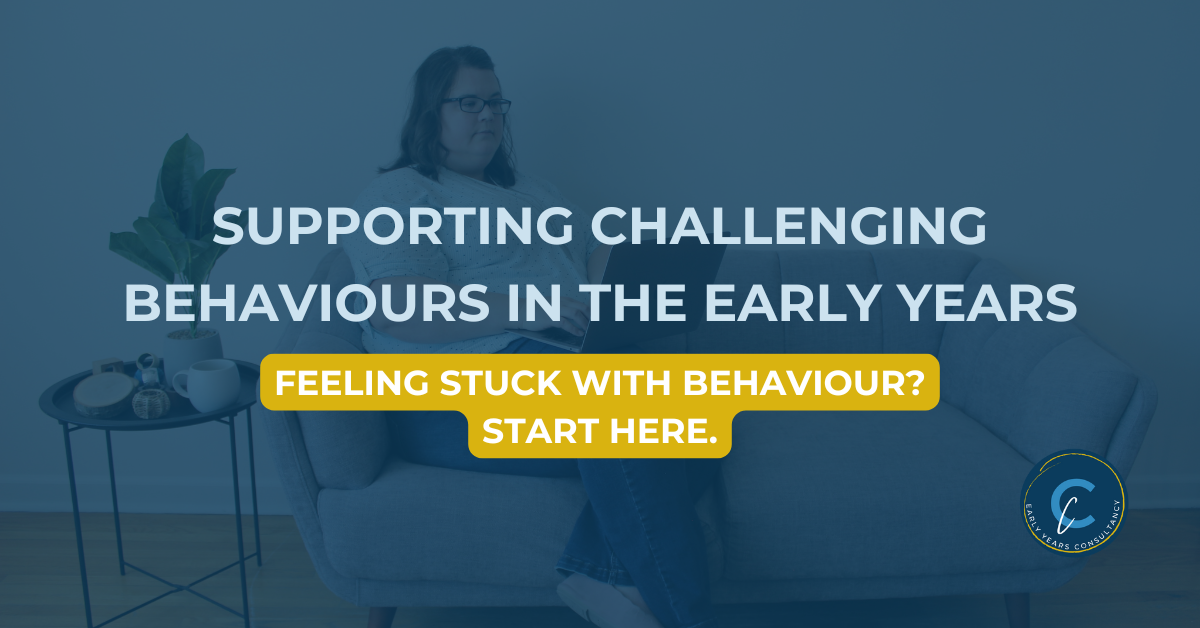
inspiring & practical ideas
GET STARTED WITH
loose parts play
FREE DOWNLOAD
This guide is loaded with ideas, inventory lists, and resources to support you in conveying the learning that is happening while children play!
I only want creativity filling your inbox, so you'll see inspiration and support dropping in...but not too much!
We respect your privacy. Unsubscribe at any time.
Supporting Challenging Behaviours in the Early Years
Challenging behaviours in the early years can be overwhelming—for educators, families, and children alike. In this post (and video), we’ll explore a new way to understand these behaviours through a more supportive and reflective lens.
👇 Watch the video below, then keep reading for the full breakdown and links to helpful resources.
👉 Click here to download The Behaviour Decoder Guide
(You’ll find it helps you start observing behaviour through new eyes.)
If you’ve found yourself thinking, “Why isn’t anything working?”—you’re not alone.
Challenging behaviours in the early years can leave even the most experienced educators feeling exhausted, defeated, and overwhelmed. You’ve tried the strategies you were taught—redirection, I-messages, sticker charts. Sometimes they help, but other times…it feels like nothing changes.
Maybe you’re walking on eggshells through transitions.
Maybe you’re second-guessing your every response.
Maybe you’re wondering if you’re doing something wrong—or if this is just the new normal.
But here’s what I want you to know:
Behaviours can be figured out.
Not fixed. Not eliminated.
But understood.
Why Traditional Behaviour Strategies Aren’t Always Enough
Let’s be honest—many of us were trained to “manage” behaviours, not to understand them.
We were given scripts, charts, and techniques that focus on the surface of what’s happening. Strategies like I-messages, redirection, and consistent routines can be helpful—they’re solid tools in your toolkit. But if you’ve found yourself thinking:
- “Why isn’t this working anymore?”
- “I’ve tried everything, and I’m still stuck…”
- “This child just isn’t responding the way others do…”
You’re not doing anything wrong. And you’re definitely not failing.
Those strategies aren’t bad. But sometimes, they’re simply not enough on their own.
They were never meant to address every behaviour, in every child, in every context—especially not without deeper reflection on the child’s individual needs, environment, and development.
When we treat those tools as the only approach, we end up feeling frustrated—and so do the children in our care.
What we need is a way to go deeper. To move beyond compliance and into connection.
To see behaviour not just as something to manage, but as something to understand.
That’s where a new mindset—and a new framework—can make all the difference.
A New Way to See Challenging Behaviours: Unsolved Problems, Not Misbehaviour
If there’s one mindset that has radically changed the way I approach behaviour—it’s this:
💬 “Kids do well if they can.”
Not “Kids do well if they wanna.”
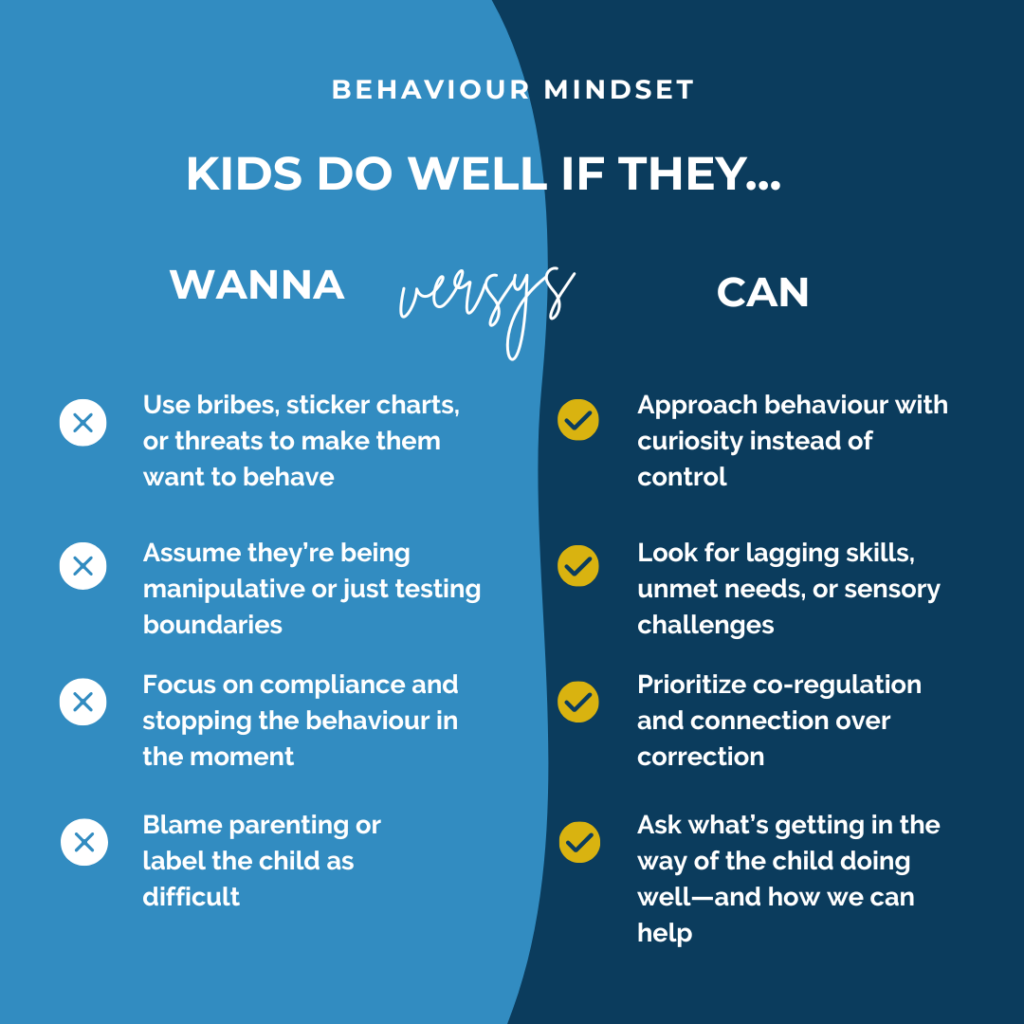
This simple shift in thinking, introduced by Dr. Ross Greene, is powerful. When we assume a child wants to behave poorly, we respond with control and correction. But when we see that a child is struggling—not defying—we show up with curiosity and compassion.
Here’s what this means in practice:
- Behaviour isn’t the problem—it’s a signal that something isn’t working.
- Behind every outburst, meltdown, or defiant moment is an unsolved problem.
- The solution isn’t more consequences—it’s collaboration, observation, and support.
You don’t need to fix every behaviour immediately. But when you start to look at them as unsolved problems—opportunities to understand and connect—you open the door to real change.
This is the first step in seeing behaviour through a new lens.
Now let’s explore four of them.
How to Understand Challenging Behaviours in the Early Years: 4 Lenses to Decode What’s Really Going On
There isn’t one cause behind every challenging behaviour. But when we can look deeper, we often discover that what seems like defiance, disruption, or attention-seeking is actually something else entirely.
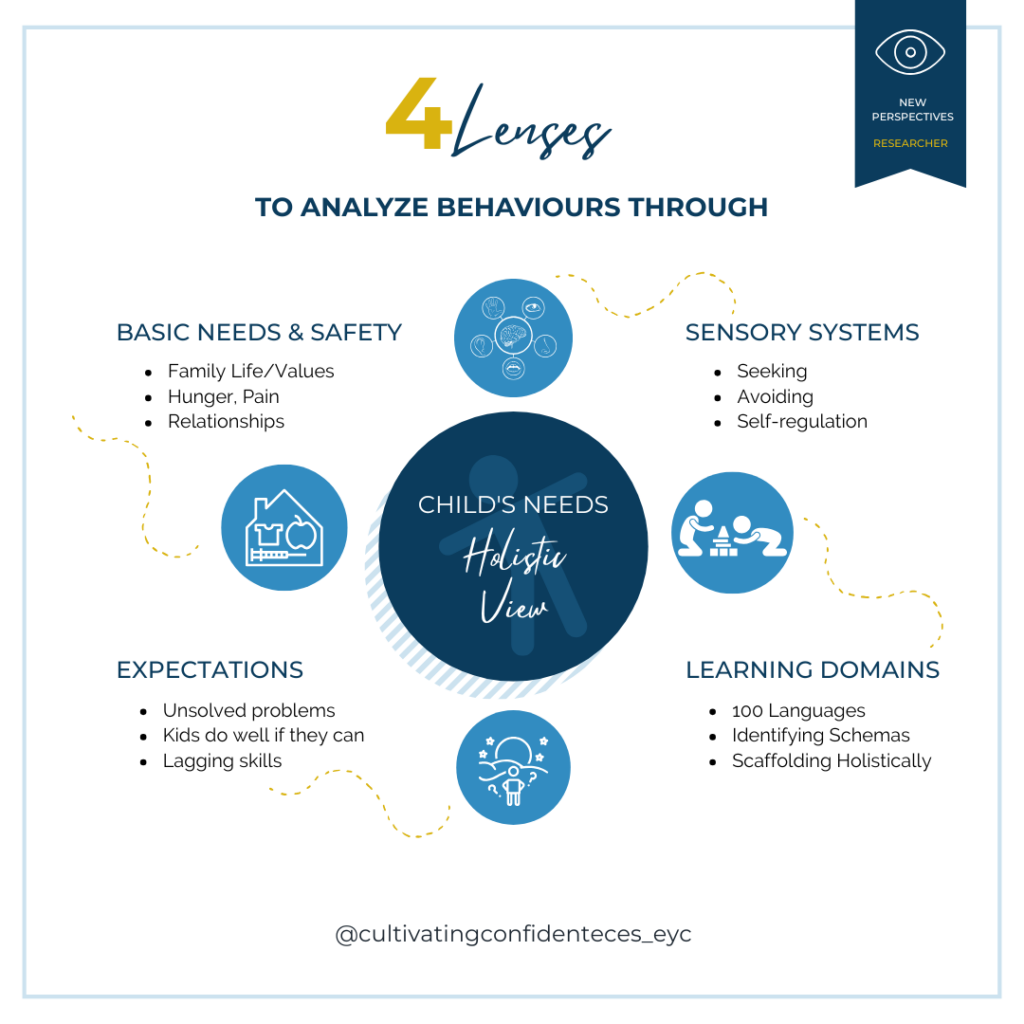
These 4 lenses help us do just that.
They offer a holistic way to pause, reflect, and respond with more clarity and connection.
1. Safety & Relationship
“Do I feel safe, seen, and connected in this moment?”
Safety isn’t just about physical needs like food or shelter—it’s also about emotional safety. Children need to feel like they belong, like someone “gets them,” especially when their behaviour is hardest to be with.
Sometimes, what looks like “attention-seeking” is really connection-seeking. And if a child doesn’t feel emotionally safe, they might test boundaries just to get reassurance that you’re still there.
Example: A child who constantly interrupts or “acts out” during group time might be showing you, “I don’t feel secure or included here.”
🌀 “Feeling safe is a child’s right—but it’s a privilege for us to help create that safety.”
Reflect: What helps you feel safe in a new or overwhelming space? How might that be different for the child in front of you?
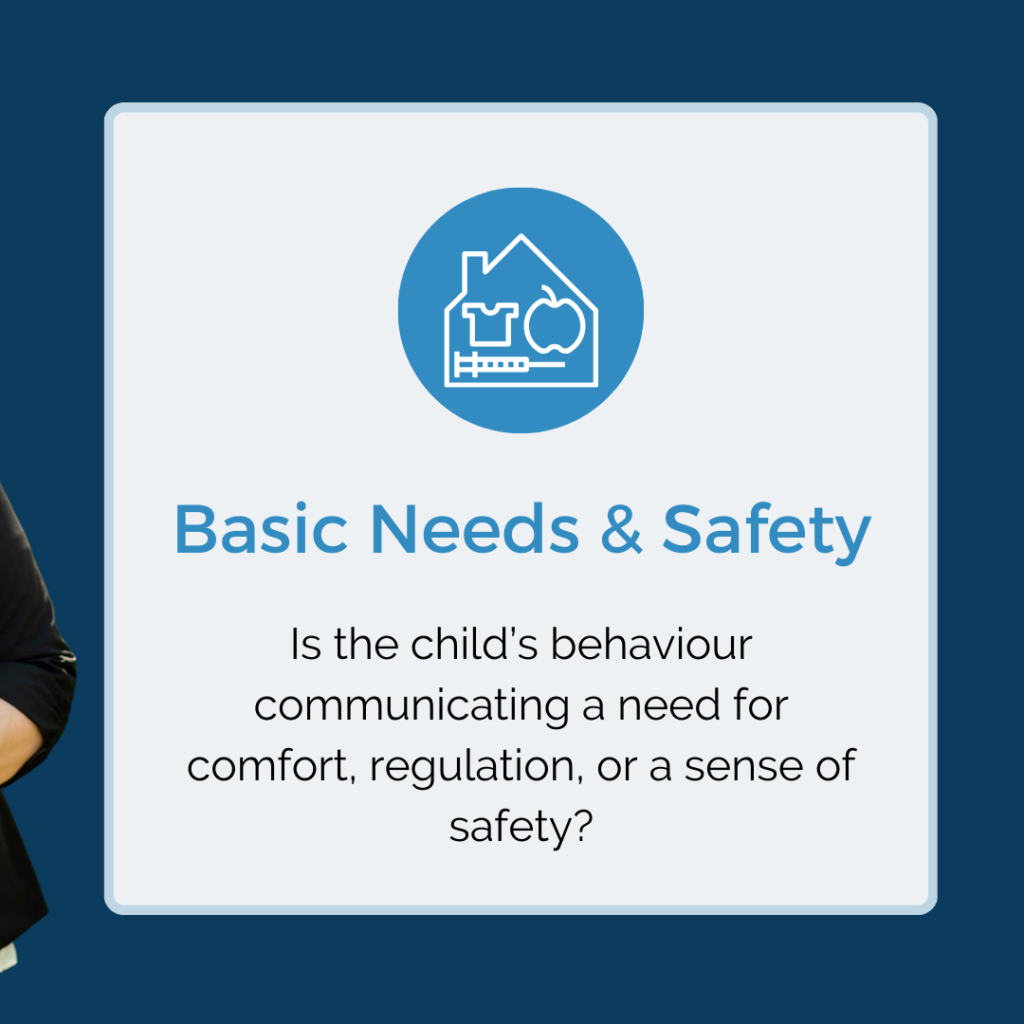
2. Sensory Processing
“Is this child overstimulated, under-stimulated, or seeking input to regulate?”
Our sensory systems shape how we experience the world. Some children are highly sensitive to noise, lights, textures, or transitions. Others seek deep pressure, movement, or stimulation to feel grounded.
These responses aren’t “bad”—they’re individual sensory needs. When we understand this, we stop trying to “fix” the behaviour and start supporting the nervous system.
Example: A child who throws themselves on the floor, bangs into furniture, or gets “too rough” during play might actually be trying to regulate their body, not misbehaving.
👉 Explore this more in my blog post:
Sensory Processing and Connections to Behaviours →
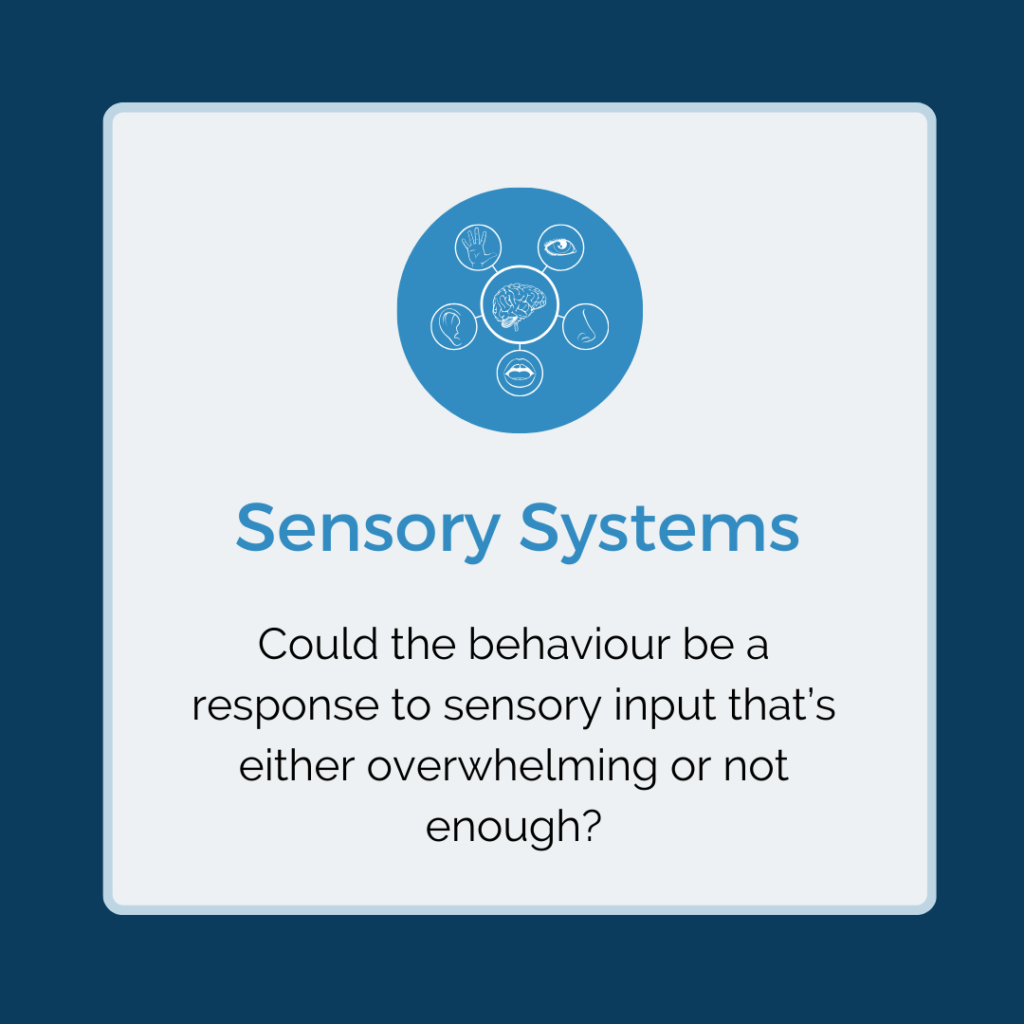
Reflect: What’s one sensory trigger or preference you’ve noticed in a child recently? How might it be influencing their behaviour?
3. Expectations
“Are the demands being placed on this child aligned with their current skills?”
Sometimes, what looks like defiance is really a mismatch between what’s being asked and what the child can actually do—emotionally, socially, or developmentally.
Children don’t thrive under pressure to perform skills they haven’t mastered yet. And when we meet them with expectations instead of support, behaviours tend to escalate.
Example: A child who refuses to clean up might not yet have the sequencing or regulation skills to transition from play to task without adult support.
Reflect: Are there times when we’ve expected “compliance” instead of offering co-regulation? Where could we reduce the load while still holding compassionate boundaries?

4. Development & Play
“Could this be a developmental need, learning schema, or emerging skill?”
Children explore the world through play, movement, and repetition. What we sometimes label as “misbehavior” is actually a child investigating a learning pattern—or expressing an emerging skill they haven’t mastered yet.
Example: Throwing might not be “bad behaviour.” It could be frustration… or a child exploring the trajectory schema through cause-and-effect play.
👉 Read more in my post on schemas in play:
Schemas in Children’s Play →

Reflect: What if you saw this behaviour not as a problem, but as a question the child is asking through their actions? How would that change your response?
A Personal Story: Diaper Changes & Bright Lights
When my son was a toddler, every diaper change became a battle. Screaming, kicking, flipping over—I ended up doing things I never thought I would as an educator, like pinning him down just to get through it.
At first, I thought it this challenging behaviour was defiance. But when I started learning about sensory processing, I realized something important: the bright bathroom lights were physically painful for him.
His behaviour wasn’t about saying no to me. It was about protecting himself.
That moment reframed everything I thought I knew—not just about my son, but about all the children in my care.
The First Step: Look Beneath the Behaviour
We often say, “Behaviour is communication.” And that’s true. But it’s also just the starting point.
If you’re in the thick of it right now—deep in the frustration of a behaviour you don’t yet understand—please know this:
You don’t need a one-size-fits-all solution.
You need a way to see the child differently.
That’s why I created a short video walking you through these 4 lenses—and a free reflection guide to help you apply them to real situations in your practice.
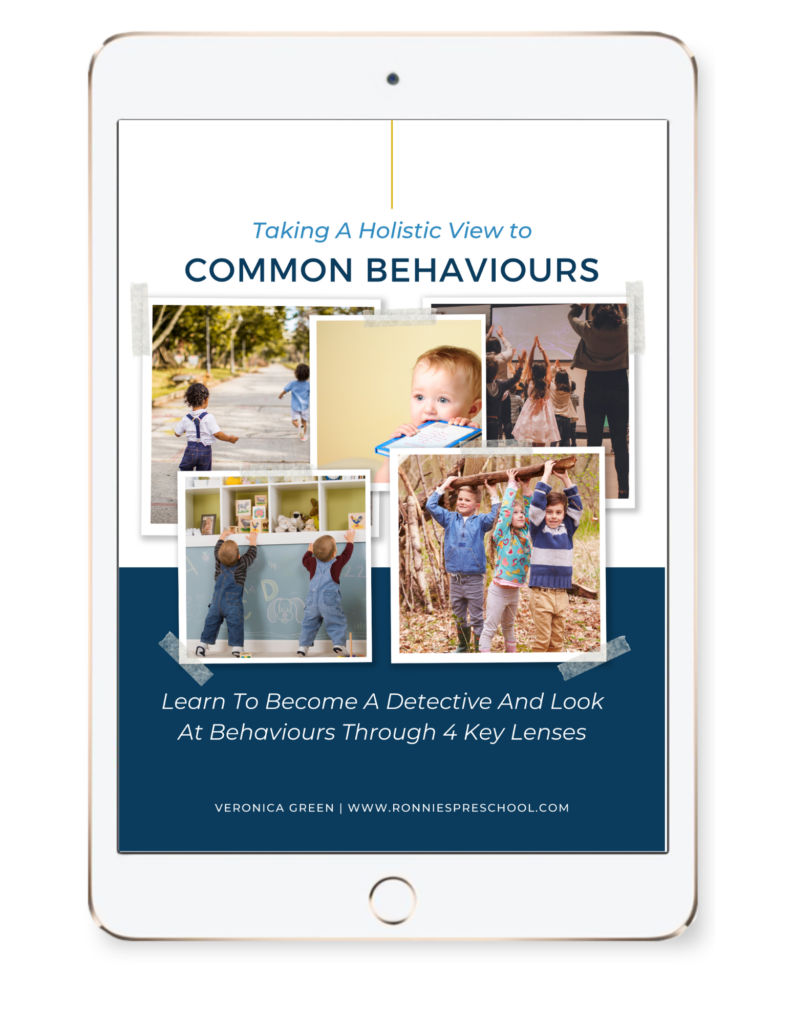
Your fellow educator, Paola from Kinderoo Children’s Academy had to say this,
“In love with this new guide Veronica! It’s an easy and practical guide that belongs in every classroom!”
👉 Click here to download The Behaviour Decoder Guide
(You’ll find it helps you start observing behaviour through new eyes.)
The Reflective Practice Pathway: Supporting Challenging Behaviours with Reflection and Intention
This post isn’t about solving every behaviour overnight.
It’s about shifting how we see children—and how we see ourselves in those tough moments.
That’s why I created the Reflective Practice Pathway—a simple but powerful approach I bring into all of my resources, workshops, and guides. It helps educators move from stuck and reactive… to confident and intentional.
Here’s how it works:
🔍 Research
We begin with curiosity. We explore ideas like the 4 Lenses, sensory processing, or play schemas—not to memorize them, but to expand what’s possible.
✨ Prompt: What’s one idea from this post (or video) that challenges how you’ve typically seen behaviour?
💭 Reflect
Then we pause. We consider how these ideas apply to our own setting, our relationships, and the children in front of us. This isn’t about judgment—it’s about insight.
✨ Prompt: Where might your current approach be out of sync with what a child is truly communicating?
🔁 Renew
Finally, we take one small, aligned step forward. We try something new in our environment, our response, or our mindset—and observe what happens next.
✨ Prompt: What’s one small shift you could try this week that feels supportive—for you and the child?
This pathway isn’t linear. It’s something we come back to again and again—because behaviour isn’t a checklist. It’s an ongoing invitation to learn, grow, and connect more deeply.
If this perspective resonates with you, I invite you to:
- Watch the full video above
- Download the free guide
- Join me in using this Reflective Practice Pathway as a tool for making sense of behaviour and finding your footing again.
You don’t need a script or a quick fix.
You just need a framework—and a guide to walk with you.
Let’s take that first step together.
MORE RESOURCES
The Behaviour Decoder – Free guide with the 4 lenses in action around common behaviours such as biting, hitting, throwing and defiance.
The Modern Educator Toolkit – Dive into 7 hours of self-paced online PD on loose parts, planning provocations, solving behaviours and supporting sensory needs.
Hey there!
I'M VERONICA
I am an Early Childhood Consultant and very passionate about supporting and inspiring my fellow Educators. I will share my reflections and experiences about implementing my philosophy, views, and ideas into my practice.
COFFEE & BOOK LOVER
find more on
stay connected
Supporting Challenging Behaviours in the Early Years
Leave a Reply Cancel reply
ENDLESS POSSIBILITIES OF
loose parts play
ON-DEMAND FREE TRAINING
Unlock the possibilities to simplify your planning, become proactive with behaviours & enjoy your role again! I'll guide you to find the beauty in loose parts play.
DISCOVER THE POSSIBILITIES!
I'M VERONICA.
EARLY YEARS CONSULTANT
Here to help you simplify planning, understand behaviours & build strong relationships...all with the magic of loose parts!
ENGAGE YOUR CURIOSITY
MY EARLY YEARS JOURNEY
THE MODERN EDUCATOR TOOLKIT
WORKSHOP (LIVE & REPLAYS)
CUSTOM TEAM PD BUNDLE
POSSIBILITIES OF LOOSE PARTS TRAINING
CONTACT
get your
guide!
Wanna know how to GET STARTED with these magical materials?
find out right here!
back to top
WEEKLY EMAIL
join the
let's stay connected...
Only inspiration & support will drop in your inbox. Unsubscribe at anytime.
CLOSE
I'M VERONICA.
Here to help you simplify planning, understand behaviours & build strong relationships...with the magic of loose parts!
VERONICA
POSTED BY:
also known as Ronnie!
SPECIAL NEEDS MOMMA &
EARLY CHILDHOOD CONSULTANT
Inspiring and mentoring my fellow educators how to use loose parts to enhance all aspects of their practice. I share my dual roles of educator & momma and how our autistic son has shown me so many new perspectives.
read about my early years journey